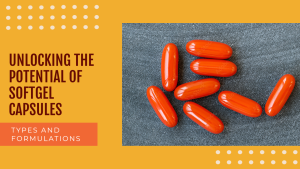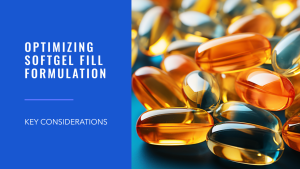Gelatin Shell Material and Formulations for Softgels: An In-Depth Guide

Gelatin, a versatile protein derived from animal sources, is crucial in producing softgel capsules. Known for its ability to form gels in aqueous solutions, gelatin provides the perfect medium for encapsulating various substances. This comprehensive guide will explore the different aspects of gelatin used in softgel production, including its properties, types, manufacturing processes, and applications.
Gelatin Shell Material
Gelatin is a protein from animal sources, primarily bovine, porcine, and piscine. It is nonallergenic, recognized as safe by the FDA, and listed in the National Formulary (CAS 9000-70-8). Gelatin is hydrophilic, meaning it loves water and forms a semi-solid colloidal gel known as a hydrogel when combined with water.
Sources of Gelatin
- Bovine: Derived from bones or skins.
- Porcine: Obtained from pig skins and bones.
- Piscine: Sourced from fish skins.
Types of Gelatin
Gelatin can be classified based on the manufacturing process:
- Acid Process (Type A): This process involves soaking raw materials in dilute acid, followed by extraction at a low pH. It is used mainly for skin and connective tissues.
- Alkaline Process (Type B): Uses successive lime solution treatments to break down collagen from bones or hides. Type B gelatin is known for producing stronger gels with less leakage.
Typical Gelatin Specification for Softgels
- Type A and B: Medium Bloom gelatins.
- Characteristics: Vary in gel strength, viscosity, pH, and microbial counts.
Properties of Gelatin
- Molecular Structure: Gelatin consists of helical peptide chains forming a gel matrix that holds water.
- Amphoteric Protein: Gelatin can react as an acid and a base due to its active functional groups: amine (-NH2) and carboxyl (-COOH). Its amphoteric nature allows it to form gels under various conditions.
- Solubility and Melting Point: Gelatin is soluble in warm water and partially in cold water. It has a melting point below body temperature (<35°C), making it ideal for softgel applications.
- Water Absorption: Gelatin can absorb 5-10 times its weight in water, influencing its structural and mechanical properties.
- Thermal Stability: Gelatin gels are thermally reversible, forming a solid gel at room temperature and melting upon heating. This property is crucial for softgel manufacturing.
- Thixotropic Nature: Gelatin exhibits thixotropic properties, meaning it becomes fluid when stirred and gels when left undisturbed. This behavior is essential for the encapsulation process.
- Glass Transition Temperature: Gelatin undergoes a glass transition at around 64°C with a moisture content of 13%, transitioning from a dry to a liquid state without melting.
- Molecular Weight: Gelatin has a molecular weight distribution of 20,000 to 100,000 Daltons. Lower molecular weight results in lower gel strength and viscosity.
Gelatin Preparation
Before use in encapsulation, the gelatin solution is heated to 70°C – 80°C and then cooled to 55°C – 57°C to reform the protein structure, ensuring a strong and elastic material for softgel shells.
Gelatin Shell Formulations
The shell comprises gelatin, a plasticizer (e.g., glycerin, sorbitol), and water, with optional colorants, flavorings, and preservatives.
Basic Composition
The softgel shell comprises:
- Gelatin: 40-50%
- Plasticizer: 30-35%
- Water: 20-30%
Plasticizers
Plasticizers like glycerin and sorbitol/sorbitan mixtures are added to improve flexibility and reduce brittleness.
Functions
Plasticizers weaken the intermolecular attractions between polymer chains, enhancing the elasticity and toughness of the gelatin shell.
Types
- Glycerin: Commonly used for its plasticizing and humectant properties.
- Sorbitol: Another plasticizer that helps maintain shell flexibility.
Colorants and Additives
Types
- Natural Colorants: Derived from sources like beta-carotene, chlorophyll, and caramel.
- Synthetic Colorants: Include FD&C-approved dyes and lakes.
Effects on Softgel Appearance
Colorants can influence the clarity, opacity, and overall appearance of the softgel capsule, making them visually appealing and easy to identify.
Shell Hardness and Viscosity
The ratio of plasticizer to gelatin affects the shell’s hardness. Higher plasticizer content results in softer shells, while lower content yields more rigid shells suitable for various climatic conditions.

Quality and Testing
- Bloom Strength: Gelatin’s cohesive strength is measured by Bloom value, with higher values indicating stronger gels. Softgels typically use gelatin with Bloom strengths ranging from 150 to 200.
- Viscosity and pH: For softgel production, viscosity is maintained within a range of 11,000 (±) 2,000 centipoises. Optimal pH ranges between 5 and 7, and viscosity is controlled to ensure proper encapsulation.
Challenges and Solutions
Crosslinking and Gel Degradation
Crosslinking, caused by interactions with fill materials or environmental factors, can lead to delayed disintegration of softgels. To mitigate this, additives like glycine or antioxidants are used to stabilize the gelatin.

Migration Issues
Migration of plasticizers or moisture from the shell to the fill can affect softgel integrity. Adjusting gelatin formulations and adding moisture-trapping ingredients can help prevent this.

pH and Fill Compatibility
The pH of the fill material must be compatible with the gelatin shell to prevent leaks. Buffering agents are often used to maintain the desired pH level.
Maillard Reaction
This non-enzymatic browning reaction occurs between reducing sugars and amino acids in gelatin, causing discoloration and potential crosslinking issues.
Most Common Physical Defects

Future Trends
Vegetarian and Vegan Softgels
With growing consumer demand for plant-based products, alternative materials like modified starches and carrageenan are being developed for vegetarian and vegan softgel shells.
Starch-Based Shells
Starch-based softgel shells are an alternative to gelatin, catering to vegetarians and those with dietary restrictions.
Challenges
Starch-based shells require different manufacturing processes and have distinct physical properties compared to gelatin.
Key Takeaways
- Gelatin is a versatile material widely used in softgel production due to its gelling properties.
- Manufacturing Processes and the choice of gelatin type (acid vs. alkaline) affect the final product’s quality and stability.
- Plasticizers are crucial for making gelatin pliable and suitable for softgel capsules.
- Control of production parameters like viscosity, pH, and temperature is essential for maintaining gelatin quality.
- Alternatives to gelatin, like vegetarian shells, are becoming more popular due to dietary preferences and regulatory concerns.
- Advanced Gelatin Formulations: Innovations in gelatin processing and formulation lead to improved softgel stability, bioavailability, and functionality.
- Specialty Products: Enteric-coated gelatin softgels protect sensitive ingredients from stomach acids, ensuring they reach the intestines for absorption.
Real-World Applications
Gelatin’s versatility makes it indispensable across various industries. It is used in food products like marshmallows, gummy bears, and jelly. In pharmaceuticals, softgel capsules are a significant application, offering an effective delivery system for various medications and supplements. Cosmetic products also benefit from gelatin’s film-forming properties, which are used in face masks and other skincare items.
Expert Insights
Developing a successful gelatin shell material and formulations for softgels requires collaboration between formulation scientists, quality assurance experts, and manufacturing engineers.
Vitor Antraco says, “Developing a successful gelatin shell material and formulations for softgels requires collaboration between formulation scientists, quality assurance experts, and manufacturing engineers.”
Sair Torregrosa adds, “Understanding gelatin’s detailed properties and behaviors and how they interact with various additives and fill materials is crucial for creating high-quality softgels.”
Conclusion
Gelatin is a versatile and essential material used to produce softgel capsules. Its unique properties make it ideal for encapsulating a wide range of substances. Understanding its properties, manufacturing processes, and applications is crucial for producing high-quality softgels that meet regulatory standards and consumer demands.
Read the original text here
Source: Vitor Jacó Antraco and Sair Torregrosa, LinkedIn (68) Gelatin Shell Material and Formulations for Softgels: An In-Depth Guide | LinkedIn
See the full article series:

- Optimizing Softgel Fill Formulation: Key Considerations
- The Ultimate Guide to Soft Gelatin Capsule Manufacturing




